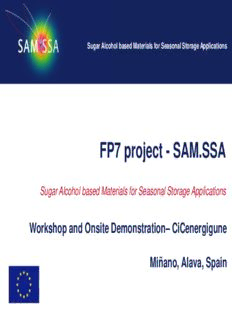
Porous structures for thermal conductivity enhancement (Alain Celzard) PDF
Preview Porous structures for thermal conductivity enhancement (Alain Celzard)
Sugar Alcohol based Materials for Seasonal Storage Applications FP7 project - SAM.SSA Sugar Alcohol based Materials for Seasonal Storage Applications Workshop and Onsite Demonstration– CiCenergigune Miñano, Alava, Spain Session 1, Sub Session: Heat Transfer Enhancement Presented by: Alain CELZARD Contributions by: Prasanta JANA Vanessa FIERRO Alain CELZARD Workshop and Onsite Demonstration ● CiCenergigune, Spain ● March 17/18, 2015 Context Phase-change materials are investigated for thermal energy storage from the 70’s, but … Challenge = seasonal storage Sugar alcohols: xylitol, sorbitol, mannitol, erytritol, etc., and their blends: “molecular alloys” Workshop and Onsite Demonstration ● CiCenergigune, Spain ● March 17/18, 2015 Context Phase-change materials are investigated for thermal energy storage from the 70’s, but … Challenge = seasonal storage Sugar alcohols: xylitol, sorbitol, mannitol, erytritol, High energy density: compact storage systems etc., and their blends: “molecular alloys” High undercooling : long-term storage Possible crystallisation by thermal shock or other means: heat recovery at the desired moment Poor thermal conductors Workshop and Onsite Demonstration ● CiCenergigune, Spain ● March 17/18, 2015 Context • Open porosity higher than 80% • Thermal conductivity within the range 3 – 10 W/m/K • Cost less than 6 €/kg • Wide pore size for easy and in-depth impregnation with SA Average thermal conductivities wanted ! A very unusual request … Why ? Workshop and Onsite Demonstration ● CiCenergigune, Spain ● March 17/18, 2015 Context Need of a medium conductivity related to the optimisation between: - Short time for heat delivery - High power delivery Crystallite growth velocity Viscosity Workshop and Onsite Demonstration ● CiCenergigune, Spain ● March 17/18, 2015 Context Effect of the thermal conductivity of the porous host on delivered power: Workshop and Onsite Demonstration ● CiCenergigune, Spain ● March 17/18, 2015 What kind of porous matrices ? Porous carbon matrices have many advantages : Cheaper than metal foams Are much lighter than metal foams Can have “green” precursors Can be prepared with any porosity Can have a broad range of physical properties Can be functionalised and/or nanostructured Require high-temperature treatment under inert atmosphere Workshop and Onsite Demonstration ● CiCenergigune, Spain ● March 17/18, 2015 What kind of porous matrices ? Most common carbon foams Reticulated vitreous carbon (RVC) foams (Derived from thermoset polymers) Duocel® RVC foam (ERG Corporation) Extremely low thermal conductivity Made from non-renewable resources Expensive Cellular graphitic carbon (CGC) foams (Derived from pitch or coal extracts) Very high thermal conductivity POCOfoam® graphite Made from non-renewable resources foam (ORNL) Prohibitive cost Workshop and Onsite Demonstration ● CiCenergigune, Spain ● March 17/18, 2015 What kind of porous matrices ? CVC and RVC foams Made from cheap (possibly renewable) resources Low cost Low thermal conductivity Cellular Reticulated Strategy : Preparing composite carbon foams containing a filler with a high thermal conductivity Workshop and Onsite Demonstration ● CiCenergigune, Spain ● March 17/18, 2015
Description: